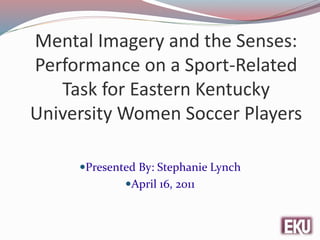
THESIS PRESENTATION
- 1. Mental Imagery and the Senses: Performance on a Sport-Related Task for Eastern Kentucky University Women Soccer Players Presented By: Stephanie Lynch April 16, 2011
- 2. Outline Inspiration of thesis Mental Imagery Introduction Review of Literature Research Question and Definitions Original Research Research Procedures Materials and Methods Results Limitations Further Direction
- 3. Inspiration Division I Athlete “Does mental imagery give an athlete an edge in performance?” http://www.ekusports.com/images/2010/8/25/large_Team_Picture_Web.jpg
- 4. What is Mental Imagery? • Create or re-create an experience in the mind • Goal: To enhance performance • Goal: Learn a new task • Imagery example: Taking a walk in the ravine http://farm1.static.flickr.com/72/226745888_67e3267fc4.jpg
- 5. Review of Literature Robert Weinberg, “Does Imagery Work? Effects on Performance and Mental Skills” – Preparatory Imagery improves performance – Factors affecting effectiveness of imagery • Perspective • Task type – open or closed • Skill level • Time of imagery • Simulation to actual environment
- 6. Weinberg continued • Future Directions for research – Imagery and the Use of Different Senses
- 7. Review of Literature The McWhiter’s “Increasing Human Potential: Relaxation and Imagery Training (RIT) with Athletic and Performing Art Teams” – Developing guided fantasy scripts • 1. 5 senses • 2. Vividly set the scene • 3. Outside to inside environment • 4. Guide the fantasy from the viewpoint of performer • 5. Use positive statements.
- 8. Research Question Original Idea- Does mental imagery give an athlete an edge in performance? Complications Mental Imagery and the Senses... Does the number of senses imagined effect performance on a closed-skill task for EKU Women soccer players in the off-season?
- 9. Definitions Mental Imagery- Using all of the senses, or at least the ones that are most appropriate to create or re-create an experience in the mind Closed-skills task (Shooting a free-throw) Off-season (non-competitive season)
- 10. Original Research Objectives: – Investigate athletes use of mental imagery – Implement mental imagery scripts – Determine what was imagined during scripts – Athlete’s perception of performance – Determine if the number of senses imagined effect performance on a closed skills task
- 11. Subject Population • Returning players on the Varsity EKU Women's Soccer team • Non-competitive season in Spring 2011 • 16 athletes, freshman to junior status • Ages 18 to 21 Recruitment • Informed and encouraged by the coach http://www.ekusports.com/images/2010/8/24/xsmall_Basalyga_Lindsay.jpg
- 12. Research Procedures • Institutional Review Board (IRB) Approval • Demographics Questionnaire • Mental Imagery Survey • Informed Consent • Informational Session • Vividness of Sport Imagery Questionnaire • Experiment • Interviews
- 14. Materials and Methods • Auxiliary Gym, Alumni Coliseum • 10 size 3 soccer balls • 3 brightly colored poster boards • Duct tape • 3 cones • Indoor shoes
- 15. Materials and Methods • 3 Randomly selected groups – Control group, 3 subjects – No mental imagery – Group A, 4 subjects – Group B, 4 subjects
- 16. • 1st Trail- Baseline • 2nd Trial- Use mental imagery script • 3rd Trial- Use mental imagery script • Time trial run – competition The Experiment:
- 17. Materials and Methods • Recorded Imagery Script Effectiveness • Recorded Vividness of Imagery • Individual Interviews Q: Were you able to hear and see certain things? What do you think kept you from imagining this? Q: Were you able to taste, feel and smell? What do you think kept you from imagining this?
- 18. Results Subject Group Baseline Trial 1 Experimental Trial 2 Experimental Trial 3 1 Green 0 1 1 2 Green 0 1 0 3 Green 0 3 2 4 Green 0 0 0 5 Pink 1 0 3 6 Pink 1 1 1 7 Pink 2 1 2 8 Yellow 2 3 2 9 Yellow 1 2 2 10 Yellow 0 3 1 11 Yellow 2 5 4 Pink: Control
- 19. Results Quantitative Fisher’s Exact Test Qualitative Significant Findings
- 20. Quantitative Results Fisher’s Exact Test • Chi-Squared test preferred but has assumptions • One or more of your cells has unexpected frequency of five or less • Fisher's exact test has no assumption and is used regardless of how small the frequency is
- 21. Quantitative Results Fisher's Exact Test – Baseline scores for the 3 groups • P-value 0.0545 – Groups significantly different at starting point – Gain-scores not significantly different for the 3 groups Insufficient evidence to show the number of senses used in mental imagery was effective in improving performance
- 22. Results Subject Group Baseline Trial 1 Experimental Trial 2 Experimental Trial 3 1 Green 0 1 1 2 Green 0 1 0 3 Green 0 3 2 4 Green 0 0 0 5 Pink 1 0 3 6 Pink 1 1 1 7 Pink 2 1 2 8 Yellow 2 3 2 9 Yellow 1 2 2 10 Yellow 0 3 1 11 Yellow 2 5 4 Pink: Control
- 23. Qualitative Results – Significant Findings • Report they felt like they improved based on the distance from the poster • Were not able to imagine smelling and tasting in most cases • Some where not able to picture themselves in the gym
- 24. Limitations • Small sample size with low numbers • Many variables – Imagery ability – Different positions on the field – Difficult task – Understanding the nature of the task and experiment
- 25. Further Direction • Perform in the competitive season • Limit variables • Develop multiple scripts of useable senses • Allow more practice using mental imagery and more repetitions http://www.ekusports.com/images/2010/9/28/rp_primary_OVCSweep_Web.jpg
- 26. Questions?
- 27. Special Thanks Dr. Wardell Johnson, mentor Lindsay Basalyga, EKU Women's Soccer Coach EKU Women's Soccer Team Dr. Michelle Smith, Statistical Consultant Eastern Kentucky University http://www.ekusports.com/images/2010/8/25/large_Team_Picture_Web.jpg